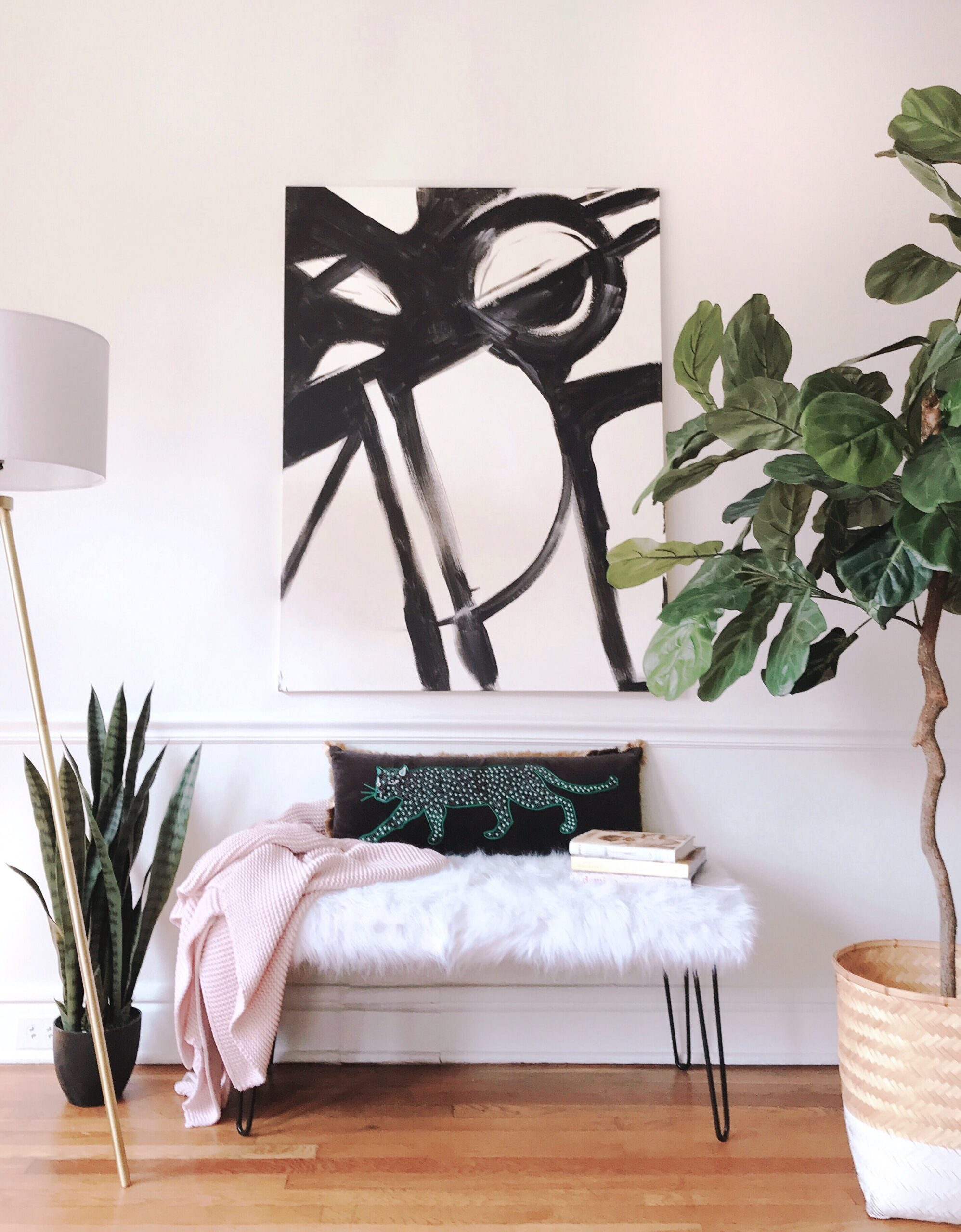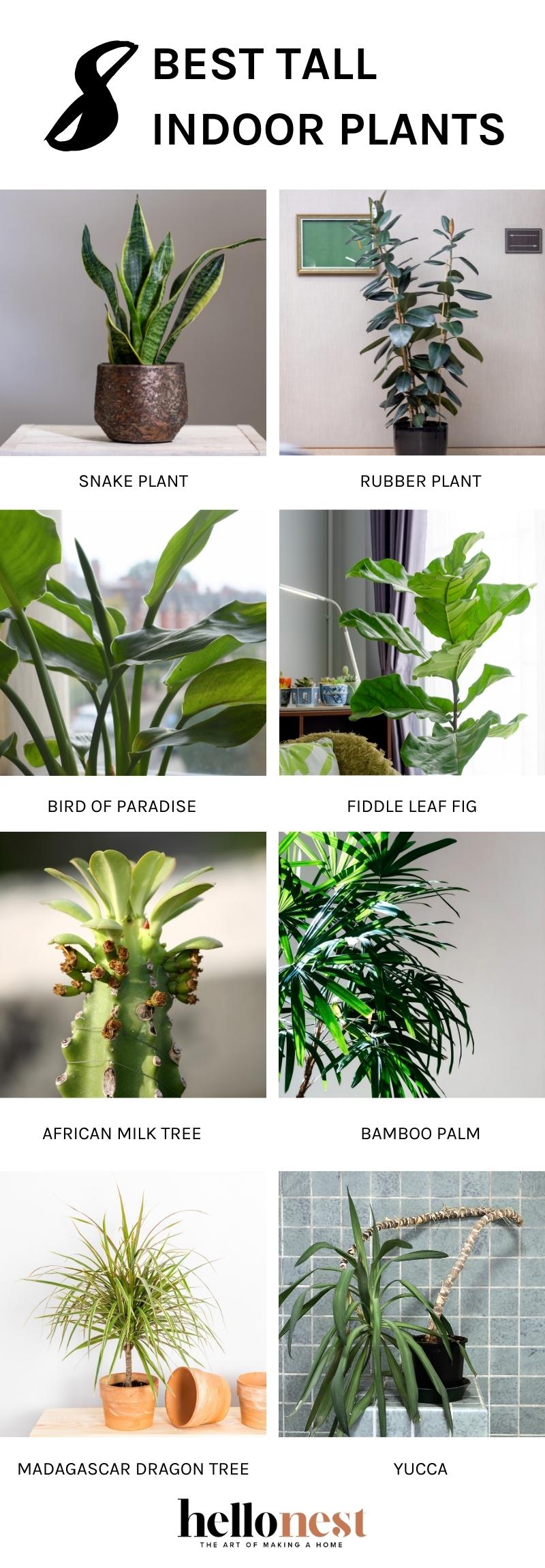Finding a plant with the right look for the right room can be a daunting task. But if you manage to find one that has an interesting structure and is sized at an appropriate scale for your room, it can add a sense of architectural balance, brightness, and interest to a space, much in the way that a beautiful sculpture or piece of art can.
A large, bold potted plant can create strong focal point and add drama. Working with an element of height in your greenery can kick up some life in an otherwise bland corner. Group together a cluster of plants of various shapes and sizes, and you’ve got a design vignette of depth and interest!
Our Favorite Tall Indoor Plants
Here are some of our favorite tall indoor plants that are perfect potted up at home. From high-humidity light-lovers to drought-resistant varietals that don’t mind a bit of neglect, take your pick and see how adding some strong vertical greens can transform the look of your space.
1. Snake Plant
If you would like your tall greens to not only add some pizzazz to your home, but also help to clean and purify the air, research shows that the snake plant (or sansevieria) is a great choice. Not only are these easy as pie — drought-resistant and low-light tolerant — they are attractive, and will filter out airborne toxins and pollutants.
This plant is also a great choice if you need a relatively tidy and contained upright plant to set on surfaces such as a shelf, mantle, countertop, or desk. Set it in any room you like, really (except for in spots of direct sunlight), and water only once the soil has dried out.
2. Rubber Plant
The rubber plant is a gorgeous house plant that can grow quite tall, though it can be pruned regularly to keep it smaller. Its large, waxy dark leaves add a nice contrast among the brighter greens, and the new leaves emerge in stunning red pod-like cylinders reminiscent of flower buds.
It’s a great choice for those looking for all beauty without the commitment. It’s hardy and robust, enjoys indirect sunlight, and only needs watering every few weeks. Check to see that the soil has dried down at least a full inch or two before watering again, and never leave it sitting around in a pool of water or the roots may rot.
3. Bird of Paradise
Another hardy plant that’s known for its large, tropical, banana-shaped leaves is the bird of paradise. If you’re looking for a plant that can handle a lot of direct or super bright sunlight, this one would be a great choice.
Wait until the top half of the soil is dry before watering, and be sure to discard any pooling water from the dish below. With the right pot and space, this one can grow up to 6 feet tall, though it does like warmth and humidity, so keep away from dry heat sources or draughty windows.
4. Fiddle Leaf Fig
As the name suggests, this fig plant has large leaves shaped like fiddles, and can act as a gorgeous focal point in any room. They can grow up to 6 feet tall if given the soil and space, and need a lot of light. If you’ve got a warm, sunny spot with minimal drafts, your fiddle leaf would thrive.
Like the bird of paradise, it also likes humidity, so feel free to mist around it once a week. Mimic the rainforest as best you can and soak it completely when watering, then allow it to dry out completely between. I set my tropicals one by one in my deep kitchen sink and give them a full shower with the spray attachment, then wait for them to drain. It can be a bit labour-intensive, but you’ll reap the rewards when you see how lush these plants can be!
5. African Milk Tree
This skyscraper succulent looks just like a cactus, and is perfect for creating that classic Southwest desert vibe, or for bringing a feeling of Mediterranean warmth to a tiled room. If properly managed, it can grow from 1-2 feet per year, eventually reaching a maximum height of around 8 feet.
Like other succulents and cactus trees, it’s drought-resistant, though should be watered when the soil has had a chance to dry out, mimicking its natural growing conditions. It prefers indirect sunlight or partial shade and dry over humid conditions. Be sure to plant in soil with good drainage.
6. Bamboo Palm
While not an actual bamboo plant, this varietal of palm is a tropical that grows naturally as an understory plant, which means under the shade canopy of the taller plants and trees. The stems and leaves are numerous but delicate, and offer a nice counterpoint to some of the larger leafed plants.
What’s great about this shaggy palm is that it offers that vibrant tropical feel in lower light spaces, and can still grow from 4-12 feet tall!
Indirect sunlight or filtered light is best, and it needs a moist soil, so watering whenever the soil has dried down about a third from the top layer is best.
7. Madagascar Dragon Tree
Here’s another beautiful tall palm that offers a bold accent to any space. It can grow in moderate conditions, low light levels, dry indoor air, and changing room conditions.
The long, spiky upright leaves can get dusty if neglected over time, so be sure to spray it down every once in a while so it can breathe. Make sure it’s in a well-drained pot, don’t let it get waterlogged, and wait for the soil to dry down between waterings. If you have curious cats, take note that this plant is toxic for them when ingested.
8. Yucca
Oh how I love my towering yucca! There have been times when I thought I had lost it for good; the trunk was looking puckered, and it was nearly falling over in its pot. I simply started paying mild attention to it again, and it bounced back as good as new.
The yucca looks more like a classic palm tree than a traditional house plant, with its strong woody cane and sharp clustered leaves at the top.
It prefers bright, indirect light, and needs well-draining soul that has a bit of heft to it, so you can try mixing in a bit of sand to keep it from falling over! They are drought tolerant, so definitely wait until the soil has dried down at least halfway before watering. When in doubt, always water less.
Not only do these tall indoor plants look striking, they can really help to bring in the feelings of serenity and warmth from the tropics into any space you like, which can feel especially awesome for those of us in cold climates with seemingly endless winters. They also help to keep the air in your home fresh and clean.
As with any house plants, keep an eye out for any sudden changes such as leaf spots, yellowing leaves, drooping foliage, or premature leaf drop, and adjust your watering/humidity/light levels accordingly. With just a bit of forethought on the average levels of light exposure and humidity in your home, you can select the right statuesque plant that will thrive happily there without too much extra fussing around.
Photo by coco tafoya on Unsplash
0

Leave a Reply